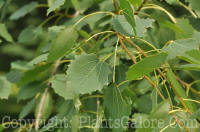 For the most part, poplars (Populus species) are not used very
much in the home landscape in the United States. They tend to be
fast growing (some grow as much as 4 feet a year) and, thus, brittle
wooded, messy and often short lived trees in the landscape.
For the most part, poplars (Populus species) are not used very
much in the home landscape in the United States. They tend to be
fast growing (some grow as much as 4 feet a year) and, thus, brittle
wooded, messy and often short lived trees in the landscape.
 Their leaves are simple and placed alternately
along the stems. The flowers and fruits lack any ornamental
value and there is little or no fall color. Poplars generally have
shallow roots and can lift portions of sidewalks or clog drain pipes
if planted too near. Many of the species are
dioecious, having a
separate male and female plant.
Their leaves are simple and placed alternately
along the stems. The flowers and fruits lack any ornamental
value and there is little or no fall color. Poplars generally have
shallow roots and can lift portions of sidewalks or clog drain pipes
if planted too near. Many of the species are
dioecious, having a
separate male and female plant.
Although its name does not tell you its genus,
the Eastern cottonwood (P. deltoides)
tree is probably the poplar species most known to people. If you
have one in your yard, it was most likely there when you built the
house. They are messy with their cottony seed discharges and their
typical poplar messiness with weak wood.
Perhaps the most commonly planted poplars have
been the Lombardy (P.
nigra) and Carolina (P. x
canadensis engenei) Poplars. These narrow, upright trees
were valued for their rapid growth and they were often planted along
each side of long driveways. Unfortunately, they are short lived
trees and, just as they start looking good at full size, they get
canker diseases and start to slowly die away. There are other
species that will fit the bill but they grow slower and will last
much longer.
The Trembling Aspen (P. tremuloides) is a
North American native that enjoys a wide distribution on the
continent. It gets its name from the flapping of the leaves in the
wind. They are most often used as a forest tree that is harvested
for the production of wood pulp for paper or other uses.